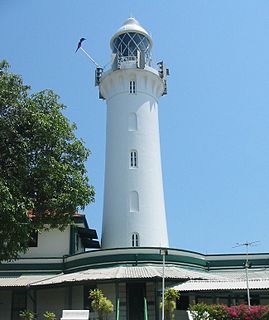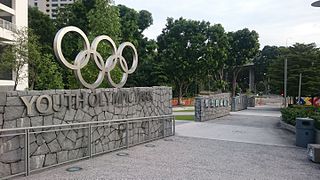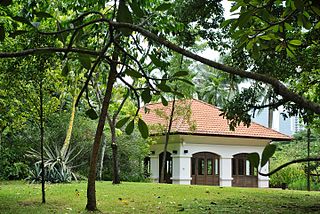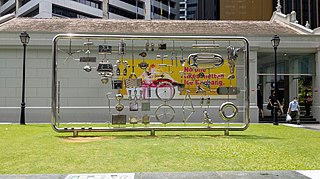
Sir Thomas Stamford Bingley Raffles was a British statesman who served as the Lieutenant-Governor of the British East Indies between 1811 and 1816, and Lieutenant-Governor of Bencoolen between 1818 and 1824. He is best known mainly for his founding of modern Singapore and the Straits Settlements.

Raffles Institution (RI) is an independent educational institution in Singapore. Founded in 1823, it is the oldest school in the country. It provides secondary education for boys only from Year 1 to Year 4, and pre-university education for both boys and girls in Year 5 and Year 6. Since 2007, RI and its affiliated school Raffles Girls' School have been offering the six-year Raffles Programme, which allows students to skip the Singapore-Cambridge GCE O-Level examinations and proceed to take the Singapore-Cambridge GCE A-Level examinations at the end of Year 6.

Raffles Hotel is a colonial-style luxury hotel in Singapore. It was established by Armenian hoteliers, the Sarkies Brothers, in 1887. The hotel was named after British statesman Sir Thomas Stamford Raffles, the founder of modern Singapore.

Raffles Place is the centre of the Financial District of Singapore and is located south of the mouth of the Singapore River. It was first planned and developed in the 1820s as Commercial Square to serve as the hub of the commercial zone of Singapore in Raffles Town Plan. It was renamed Raffles Place in 1858 and is now the site of a number of major banks. It is located in the Downtown Core within the Central Area, and features some of the tallest buildings and landmarks of the country.

The Bukit Timah Nature Reserve is a 1.7-square-kilometre (0.66 sq mi) nature reserve near the geographic centre of Singapore, located on the slopes of Bukit Timah Hill, the country's highest natural peak standing at a height of approximately 165-metre (541 ft), and parts of the surrounding area. The nature reserve is about 15 kilometres from the Downtown Core, Singapore's central business district (CBD).

The Central Catchment Nature Reserve is the largest nature reserve in Singapore, occupying 2880 hectares. Forming a large green lung in the geographical centre of the city, it houses several recreational sites, including the Singapore Zoo, the Night Safari and the River Safari, as well as several newer facilities built to encourage public appreciation of the reserve, such as the HSBC TreeTop Walk. The reserve sits within the boundaries of the Central Water Catchment. It is one of the four gazetted nature reserves in Singapore. The other three are the Labrador Nature Reserve which was gazetted since 1 January 2002, Sungei Buloh Wetland Reserve and Bukit Timah Nature Reserve. All four nature reserves along with the parks are protected under the Parks & Trees Act 2005.

The Downtown Core is the historical and downtown centre of the city-state of Singapore and the main commercial area in Singapore excluding reclaimed lands with many integrated resorts such as the Marina Bay Sands, one of the most expensive buildings in the world, with a luxurious standalone casino at Bayfront Avenue. There are many skyscrapers in Raffles Place, Tanjong Pagar and Marina Bay CBD with a height limit of 280m. It is one of the eleven planning areas located within the most urbanised Central Area, forming the latter's dense urban core. It is bounded by Rochor to the north, Kallang to the northeast, Marina East and Marina South to the east, Straits View to the southeast, Bukit Merah to the south, as well as Outram, Museum and Singapore River to the west.

The establishment of a British trading post in Singapore in 1819 by Sir Stamford Raffles led to its founding as a British colony in 1824. This event has generally been understood to mark the founding of colonial Singapore, a break from its status as a port in ancient times during the Srivijaya and Majapahit eras, and later, as part of the Sultanate of Malacca and the Johor Sultanate.

The Padang is an open playing field located within the Downtown Core of the Central Area in Singapore. It includes the Padang Cricket Ground. The Padang is surrounded by several important landmarks, which include Saint Andrew's Cathedral, City Hall, the Old Supreme Court Building and the City Hall MRT station.

Fort Canning Hill, formerly Government Hill, Singapore Hill and Bukit Larangan, is a small hill, about 48 metres (157 ft) high, in the southeast portion of the island city-state of Singapore, within the Central Area that forms Singapore's central business district. It is named after Viscount Charles John Canning, the first Viceroy of India. Although small in physical size, it has a long history intertwined with that of the city-state due to its location as the highest elevation within walking distance to the city's civic district, within the Downtown Core. It is also a popular location for exhibitions, concerts and outdoor recreation.

The Arts House is a multi-disciplinary arts venue in Singapore. The venue plays host to art exhibitions and concerts. Built in 1827, the Old Parliament House is the oldest government building and perhaps the oldest surviving building in Singapore. The building was home to the Parliament of Singapore from 1965 to 1999, when it moved to an adjacent new building.

Shenton Way is a major trunk road serving Singapore's Central Area and is most commonly known for the commercial skyscrapers flanking both sides of the road. The road is a one-way street that starts at the junction of Boon Tat Street, Raffles Quay and Commerce Street before ending at Keppel Road.

Raffles's Landing Site is the location where tradition holds that Sir Stamford Raffles landed in on 28 January 1819. The site is located at Boat Quay within the Civic District, in the Downtown Core of the Central Area, Singapore's central business district.

Raffles Lighthouse is a lighthouse located on Pulau Satumu in the Singapore Strait, about 14 kilometres (8.7 mi) south of the main island of Singapore.

Beach Road is a road located within the planning areas of Kallang, Rochor and the Downtown Core in Singapore.

The Raffles' banded langur, also known as the banded leaf monkey or banded surili, is a species of primate in the family Cercopithecidae. It is endemic to Singapore and southern Peninsular Malaysia. The species underwent taxonomic revisions in 2019 and 2020, in which two former subspecies were elevated to separate species. As a result, the Raffles' banded langur meets the criteria for being listed as critically endangered by the IUCN. It is mainly threatened by habitat loss.

Youth Olympic Park is Singapore's first art park. It is located at Raffles Avenue, at the junction of Raffles Avenue and Bayfront Bridge.

Kallang Riverside Park is a riverine park in Kallang, Singapore. It sits on the confluence of the Kallang River and Rochor River, north of the Kallang Basin.

Raffles House is a single-storey building built on the Fort Canning Hill, Singapore. The original building was a wood and atap structure built in 1822 that was used as a place of residence by Sir Stamford Raffles. This building was later rebuilt as a neoclassical-styled Government House as the residence of subsequent colonial governors, but it was demolished in 1858 to make way for the construction Fort Canning. The present structure built on the same site is a brick and tile building constructed in 2003.

All the Essentially Essential is a sculpture in Raffles Place Park, Singapore.




















